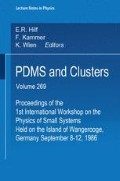Abstract
Having defined metal as a macroscopic (bulk) system, its minimum size is the size beyond which deviations form the bulk behaviour are no longer detectable. The size therefore depends on the physical property studied as well as on the sensitivity of the experimental apparatus.
We have presented some model treatments of a metallic slab. This system can be characterized by a number of scalar parameters as well as fields. As the slab thickness is varied the scalar parameters generally shift (scaling relations) while the field pattern change in space and time. Nevertheless, at least in the present model the time-pattern (frequency) and the space pattern are still found to be interrelated in terms of a dispersion relation.
Preview
Unable to display preview. Download preview PDF.
References
See, e.g., S. K. Ma, 'statistical Mechanics', World Scientific 1985
G. Mahler and A. Fourikis, J. Lum. 30 (1986) 18
J. B. Barker and D. K. Ferry, Solid State Electron. 23 (1980) 519; 531; 545
T. Welker and T. P. Martin, J. Chem. Phys. 70 (1979) 5683
M. E. Fisher and M. N. Barker, Phys. Rev. Lett. 28 (1972) 1516
D. M. Wood, Phys. Rev. Lett. 46 (1981) 749
D. J. Chodi, Phys. Rev. Lett. 41 (1978) 1062
J. L. Martins, J. Buttet, and R. Car, Phys. Rev. Lett. 53 (1984) 655
H. Stolz, ‘Einfiihrung in die Vielelektronentheorie der Kristalle', Düsseldorf 1975
C. M. Soukulis, J. V. Jose, E. N. Economou, and Ping Shen, Phys. Rev. Lett. 50 (1983) 764
H. P. Balkes and E. R. Hilf, 'spectra of finite systems', Mannheim 1976
H. M. Streib, Diplom Thesis, Stuttgart 1983
M. J. Kelly and R. J. Nicholas, Rep. Progr. Phys. 48 (1985) 1695
E. Heilbronner and H. Bock, ‘Das HMO-Modell und seine Anwendungen', Verlag Chemie 1978
W. Teich and G. Mahler, Phys. Stat. Sol(b), to be publ.
K. Shimoda (ed.), ‘High Resolution Laser Spectroscopy', Springer 1976
A similar situation as found for NMR is discussed by J. S. Ridgen, Rev. mod. Phys. 58 (1986) 433
Author information
Authors and Affiliations
Editor information
Rights and permissions
Copyright information
© 1987 Springer-Verlag
About this paper
Cite this paper
Mahler, G. (1987). From micro-systems to macro-systems: What size is a metal?. In: Hilf, E.R., Kammer, F., Wien, K. (eds) PDMS and Clusters. Lecture Notes in Physics, vol 269. Springer, Berlin, Heidelberg. https://doi.org/10.1007/3-540-17209-2_48
Download citation
DOI: https://doi.org/10.1007/3-540-17209-2_48
Published:
Publisher Name: Springer, Berlin, Heidelberg
Print ISBN: 978-3-540-17209-3
Online ISBN: 978-3-540-47404-3
eBook Packages: Springer Book Archive

